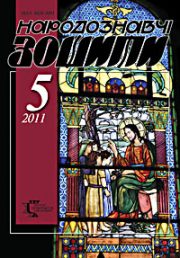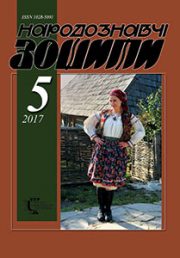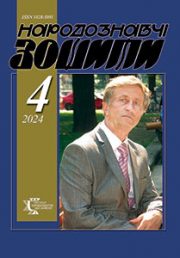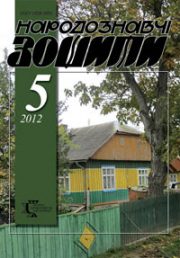The Ethnology Notebooks. 2022. № 1 (163), 3—15
UDK 316.723[394.25+392](477.8-21)”XX”
DOI https://doi.org/10.15407/nz2022.01.003
BABII Nadiia
- ORCID ID: http://orcid.org/0000-0002-9572-791X
- PhD in Art Studies, Associate Professor,
- Vasyl Stefanyk Precarpathian National University,
- 57, Shevchenka St., Ivano-Frankivsk, 76000, Ukraine,
- Contacts: e-mail: nbabij26@gmail.com
Abstract. The issues of understanding «vernacular culture» and «vernacular space» in the urban environment are considered. Various, unrelated aesthetic programs in the environments of the cities of Western Ukraine, which mark new practices of everyday life, involving the main roads, are singled out. There are three groups of implementers of «vermicular» labeling: carriers of «carnival» culture, imitating the hipster way of life, «traditionalists» — nationally and religiously conscious conservative communities, focused on established political aesthetics, «communicators», whose activities are realized by the emergence of message palimpsests. The aesthetics of the 1990s is used as a starting point for cultural transformations in the vernacular spaces today.
The purpose of the study is to identify new practices of recoding urban spaces.
The main source material is photographic material collected in field research and own reflective observations of individual random and regular street practices and processes. The practical part uses the technique of «drift» (dйrive), which emerged as the practice of «Internationale Situationniste». «Drift», formulated by Guy Louis Debord, sees urban spaces as a potential field of resistance to the existing order in search of a new way of life. Studying the techniques of space recoding, the author focuses on the concepts of «vernacular culture» and «vernacular space», formulated in the works of philosophers and anthropologists Max Lerner, and Margaret Lantis, Phil Wood. A number of dictionaries is analyzed. Useful considerations on the transformation of urban spaces by art critics and culturologists Stella Bazanyani and Bohdan Shumylovych were used. For the convenience of analysis of various markers and artifacts, conditional terminology is used to denote autonomous groups; group classification is related to the type of coding specific to the community.
Conclusions. Vernacular space is the boundary between the real practices of agents and the imaginary expectations of the contractors of space, based on their experience, reflexive perception. Ways of considering markers cause understanding of the city through actions in its space, the consequence of which is the creation of a modified city, which is again perceived and understood as an arena of action. There are three types of marking practices that are important for creating game situations that provide the necessary emotional contrast for the urban complex. The conservatism of vernacular cultures creates opportunities for political manipulation, where players — agents of practice — become game figures for commercial or political interests.
Keywords: vernacular culture, vernacular space, «carnival culture», «traditionalists», «communicators», trunk practices, public space.
Received 11.01.2022
REFERENCES
- Guy, Louis Debord. (2017). Psychogeography. Moscow: Ad Marginem Press [in Russian].
- Lerner, Max. (1957). America as a civilization; life and thought in the United States today. New York: Simon and Schuster.
- Lantis, M. (1960). Vernacular Culture. American Anthropologist, 62, 202—216.
- Wood Phil. The cycle of urban creativity. Retrieved from: https://www.culture29.ru/upload/medialibrary/575/5752b40de121145269f1c4249770f0f5.pdf (Last accessed: 15.09.2021) [in Russian].
- Vernacular. Retrieved from: https://dictionary.cambridge.org.vernacular (Last accessed: 15.09.2021).
- Vernacular. Retrieved from: https://www.dictionary.com/browse/vernacular (Last accessed: 15.09.2021).
- Bazaziani, S. (1986). Wednesday and monumental art in the coordinates of the 80s. Decorative art of the USSR, 4, 2—5 [in Russian].
- Shumylovych, B. (2018). 1993 in Lviv: transgressions and aesthetic rituals of transition. Retrieved from: https://zbruc.eu/node/80025 (Last accessed: 15.09.2021) [in Ukrainian].
- Lyuty, T. (2019). Mass and popular culture: problem of demarcation. Scientific notes of NaUKMA. Philosophy and religious studies (Vol. 3. pp. 85—99) [in Ukrainian].
- Kalutskov, V. (2013). On the types of regions in cultural geography. Cultural and humanitarian geography, 1 (Vol. 2, pp. 3—9) [in Russian].
- Babii, N. (2020). The self-value of monumental arts in the system of modern urban cultural development of Western Ukraine. Retrieved from: http://lib.pnu.edu.ua:8080/bitstream/123456789/8787/1/THE%20SELF-VALUE%20OF%20MONUMENTAL%20ARTS%20IN%20THE%20SYSTEM%20OF%20MODERN%20%20URBAN%20CULTURAL%20DEVELOPMENT%20OF%20WESTERN%20UKRAINE.pdf (Last accessed: 15.09.2021) [in Ukrainian].
- Lefebvre, A. (2015). Proizvodstvo prostranstva [The Production of Space]. Moskva: Streike Press [in Russian].
- Pyaskovsky, Yu. (1986). The city speaks to a man. Decorative art of the USSR, 1 (338), 21—26 [in Russian].
- (1983). Folk art in the midst of a modern city. Presentation of reports. Decorative art of the USSR, 5 (306), 2—15 [in Russian].
- Rubtsov, A. (1981). Self-worth is not an alternative to synthesis. Decorative art of the USSR, 7, 42—44 [in Russian].
- Byrne, D. (2016). Vernacular culture and nationalism. Retrieved from: https://davidbyrne.com/journal/vernacular-culture-and-nationalism (Last accessed: 17.09.2021).
- Eshkilev, V. Game in tradition. 2021. Retrieved from: https://matrix-info.com/gra-v-tradytsiyu/?fbclid=IwAR01vzyUe0_k9OMRbWcPiy-TTNTAyyPgIYMeekcsyxWR_vvaEpJJq2eBD7c (Last accessed: 19.09.2021) [in Ukrainian].
- (2011). Trizub, yakogo vidno z kosmosu, zrobiv veteran UPA (The trident, which can be seen from space, was made by a UPA veteran). Retrieved from: https://www.youtube.com/watch?v=p9dC_ImRXbM&ab_channel=5канал (Last accessed: 15.09.2021) [in Ukrainian].
- (2021). UkraYinets posIyav 700 kIlometrIv chornobrivtsIv i sonyashnikiv yzdovzh dorig (Ukrainian sowed 700 kilometers of marigolds and sunflowers along roads). Retrieved from: https://lviv1256.com/news/ukrajnets-prykrasyv-kvitamy-chotyry-desyatky-kilometriv-trasy-lutsk-lviv/ (Last accessed: 15.09.2021) [in Ukrainian].
- (2014). V’Yizd do Lyubomlya — v patrIotichnih kolorah (Entrance to Lyuboml — in patriotic colors). Retrieved from: https://www.volynnews.com/news/society/vyizd-do-liubomlia-v-patriotychnykh-kolorakh/ (Last accessed: 15.09.2021) [in Ukrainian].
- Ivanova, A. (2017). Carnival Design, «Do-It-Yourself» and «New Norm» Culture in the City Environment. Vladivostok; Khabarovsk. Vestnik TOGU, 3 (46), 109—118 [in Russian].
- Kozlova, I. (2016). The structure of the social space of the city in the context of the tourist orientation of the country: the place and importance of public space. In (Not) Satisfaction with public spaces. Urban Studies III (Pp. 296—304). Kiev: Vsesvit [in Ukrainian].
- Slavik’s fashion. Retrieved from: https://www.facebook.com/SlaviksFashion (Last accessed: 19.09.2021) [in Ukrainian].
- (2020, 28 january). Andrukhovych, Yu. (2017). Words words words. Zbruch. Retrieved from: https://zbruc.eu/node/63290 (Last accessed: 22.01.2021) [in Ukrainian].
- Babii, N. (2021). Popular culture as a source of ideas in the urban spaces of Western Ukraine during the pandemic. Culture and Arts in the Modern World (Issue 22, pp. 129—144).







